| Click On Image For Full Size | Size | Image Description | Source | |
|---|---|---|---|---|
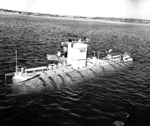 |
2.38k | Two early photos of Trieste circa 1957-1959 prior to the Marianas Trench dive. These could be photos taken during her Office of Naval Research sponsored dives in the summer of 1957 in the Mediterranean. | Photo from the files of the Vallejo Naval and Historical Museum via Darryl L. Baker. | |
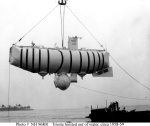 |
56k | U.S. Navy Bathyscaphe Trieste, is hoisted out of the water in a tropical port, circa 1958-59, soon after her purchase by the Navy. Photograph was released by the U.S. Navy Electronics Laboratory, San Diego, California. | USNHC # NH 96801. U.S. Naval Historical Center Photograph. | |
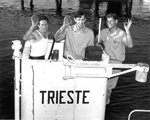 |
104k | Celebratory signals from the Trieste's crew after its first dive (to 70 feet) off the coast of San Diego, the submersible's first descent in Pacific Ocean waters. Pictured, left to right: consulting scientist Giuseppe Bruno, consulting scientist and designer Jacques Piccard and deep-sea exploration pioneer and project director Andreas Rechnitzer. | Photo & text courtesy of San Diego Union-Tribune. | |
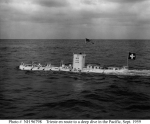 |
71k | U.S. Navy Bathyscaphe Trieste under tow, en route to a deep water dive in the Pacific, 15 September 1959. She is flying both the United States and Swiss flags. | USNHC # NH 96798. U.S. Naval Historical Center Photograph. | |
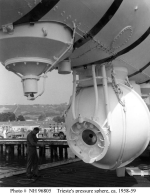 |
71k | U.S. Navy Bathyscaphe Trieste, close up view of the front of Trieste's pressure sphere, showing Plexiglas window and instrument leads. The forward ballast silo, with metering valve on its bottom, is in the upper left. Photo was taken circa 1958-59, shortly after Trieste was obtained by the Navy. It was released by the U.S. Navy Electronics Laboratory, San Diego, California. | USNHC # NH 96805. U.S. Naval Historical Center Photograph. | |
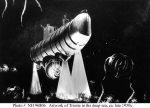 |
62k | U.S. Navy Bathyscaphe Trieste, a late 1950's artwork, depicting Trieste operating on the deep ocean floor. | USNHC # NH 96806. U.S. Naval Historical Center Photograph. | |
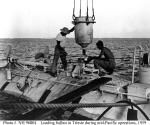 |
107k | U.S. Navy Bathyscaphe Trieste, Jacques Piccard (right), co-designer of the bathyscaphe, and Ernest Virgil loading iron shot ballast into Trieste, prior to her record 18,600 foot descent in in the Marianas Trench, off Guam. The dive was made on 15 November 1959. Photo was released for publication on 28 November 1959. | USNHC # NH 96804. U.S. Naval Historical Center Photograph. | |
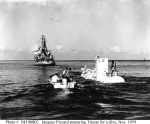 |
102k | U.S. Navy Bathyscaphe Trieste, Jacques Piccard, co-designer of the bathyscaphe, and his assistants make final checks aboard her, prior to Trieste's first deep dive in the Marianas Trench. On 15 November 1959, off Guam, she dove to 18,600 feet, breaking the previous record of 13,000 feet. Wandank (ATA-204) is in the distance, apparently towing the bathyscaphe. Navigation buoy on right indicates that the photo may have been taken as Trieste left port to make the dive. Photo was released from publication on 28 November 1959. | USNHC # NH 96802. U.S. Naval Historical Center Photograph. | |
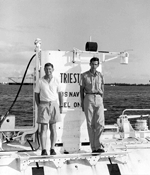 |
160k | Mankind's greatest achievements in human exploration, when U.S. Navy Captain Don Walsh (Pilot) and Swiss Explorer Jacques Piccard (Co-Pilot) set the worlds all-time depth record, 50 years ago today, on 23 January 1963 when they dove the U.S. Navy Bathyscaphe Trieste DEEP-SEA Submersible down into the Challenger Deep in the Mariana Trench off Guam, down 35,800 feeta mind-boggling record which stands to this day. In the photo we see Andreas Rechnitzer Ph.D., on the left, who was the civilian head of Project Nekton, and standing next to him on the deck of the Trieste is Swiss Oceanographer and Professor Jacques Piccard. | Photo courtesy of Life Magazine via Bill Gonyo. | |
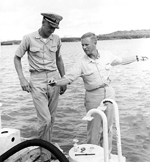 |
86k | Captain Don Walsh is pictured on the right side with his Operation Nekton team member U.S. Navy Lieutenant Larry Shumaker who is wearing his hat at Guam in November 1959. Lieutenant Larry Shumaker had previously served with Captain Don Walsh on the U.S. Navy submarine named The Rasher (SS-269). Don and Larry were great friends and Larry served as Captain Walsh's assistant, and they were classmates at the Annapolis Naval Academy. U.S. Navy Captain Don Walsh had an amazing career in the U.S. Navy. In 1958 he was a submarine Lieutenant serving on the staff of Submarine Flotilla One in San Diego, California as part of the U.S. Submarine Force. Submarine Flotilla One commanded 24 submarines along with 4 support ships which gave it a large theater of operations as part of the Pacific Fleet. | Photo courtesy of Life Magazine via Bill Gonyo. | |
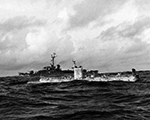 |
788k | U.S. Navy Bathyscaphe Trieste, just before her record dive to the bottom of the Marianas Trench, 23 January 1960. The dive, to a depth of 35,800 feet in the Challenger Deep, off Guam, was made with Lieutenant Don Walsh, USN, and Swiss scientist Jacques Piccard on board. Waves were about five to six feet high when the two men boarded Trieste from the rubber raft seen at left. Lewis (DE-535) is steaming by in the background. | Official USN photograph # USN 10446612 courtesy of the National Museum of the U.S. Navy, via flickr.com. | |
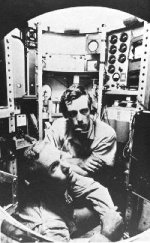 |
22k | In 1960, Swiss scientist Jacques Piccard (above in this photo) and Navy lieutenant Donald Walsh made history when they descended in the U.S. Navy Bathyscaphe Trieste, to the bottom of the Mariana Trench. The brave divers were housed in a sphere attached to the bottom of the bathyscaphe's long buoyant tank. | Photo & text courtesy of University of Delaware. (ocean.udel.edu) | |
 |
74k | The U.S. Navy's bathyscaphe Trieste is seen slung on cables out of the water in March 1959 in San Diego. Fifty years ago, two men in an odd-looking vessel out of San Diego ventured to a place no human had gone before a site as remote and dangerous as a lunar landscape. There was no air, and the atmospheric pressures were crushing up to 8 tons per square inch, strong enough to bend steel. On 23 January 1960, Don Walsh and Jacques Piccard became the first people to reach the bottom of Challenger Deep in the Mariana Trench. This spot, 35,797 feet below the surface, is the deepest surveyed point of Earth's oceans. "These guys were pioneers in the truest sense," said Kevin Hardy, vice president at Deep sea Power & Light, a submersible-technology company in Kearny Mesa. "Step by step, they pushed back the frontier and helped open up a new world. San Diego should be as proud of this as of building (Charles) Lindbergh's Spirit of St. Louis." On this January 23, Walsh and other participants in the historic dive of the Trieste bathyscaph will gather at the Town and Country Resort in Mission Valley to commemorate their achievement. "It was like putting a man on the moon," said David Sandwell, a geophysicist at the Scripps Institution of Oceanography in La Jolla, part of the University of California San Diego. He helped develop the first detailed maps of the global seafloor in the 1990s. There is one notable difference: A dozen astronauts, all from the Apollo program, walked on the moon. Walsh and Piccard remain the only humans to have delved so deeply into the Mariana Trench, an undersea subduction zone where tectonic plates collide and plunge back into Earth's molten mantle. Only two unmanned attempts have successfully replicated the feat: a Japanese robotic probe called Kaiko in 1995 and a remotely operated American vehicle named Nereus last year. The Trieste was the creation of Auguste Piccard, a Swiss physicist who invented a pressurized aluminum gondola that set a balloon altitude record of 51,775 feet in 1931. He then shifted his attention downward, realizing that his gondola might also take humans into the depths of the sea. His first bathyscaph a word Piccard coined from the Greek "baths," meaning deep, and "scaphe," meaning ship was built and sold to the French navy. Piccard used the proceeds to construct and launch the Trieste in 1953. The vessel was named after the Italian city where much of it was built. By today's standards, the Trieste technologies were relatively crude. Two people occupied a 6½-foot steel sphere that was attached underneath a 50-foot-long steel float filled, in part, with 28,000 gallons of buoyant aviation fuel. To descend, the crew flooded air-filled ballast tanks. To ascend, internal hoppers released tons of iron pellets. A cash-strapped Piccard sold the Trieste to the U.S. Office of Naval Research in 1958 for $250,000. The Navy was looking for a vehicle capable of deep-sea ventures. It had the bathyscaph shipped to San Diego for testing and modifications over the next year and a half. In 1959, Walsh, a 27-year-old submarine lieutenant, volunteered to become the Trieste's first officer in charge. It got him out of shore duty, though later he said no one had told him about the Challenger Deep plans. "The subs I had worked operated at maximum depths of 300, 400 feet," he said. "But I wasn't concerned. It just made me more curious." The project was headed by Scripps graduate and deep-sea pioneer Andreas Rechnitzer of the Naval Electronics Laboratory on Point Loma. Jacques Piccard, the son of Auguste, served as a consultant. Their goal was simple: Prove that humans could safely explore the ocean's depths. The Trieste's descent 23 January 1960, was largely uneventful. The dive began at 8 a.m. in rough seas, but once beneath the waves, the craft plunged smoothly and steadily at a rate of about 180 feet per minute. It took nearly five hours to reach the sea bottom nearly seven miles down. Walsh recalls the downward trip as being relatively boring. He and Piccard, who died in 2008, monitored a handful of instruments, looked for leaks and watched passing bioluminescent creatures from the sphere's single porthole. The only moment of excitement happened at 31,000 feet, when the crew heard a loud bang. "Since our instruments indicated no problems and we were still alive, Jacques and I decided to proceed," Walsh said. The bang turned out to be a secondary Plexiglas window in the entry tube cracking from changing sea pressures, though it posed no mortal threat. Walsh and Piccard remained on the sea bottom for 20 minutes. They wanted to get back to the surface before darkness, and frankly, there wasn't much to see, Walsh said. The Trieste landing had stirred up a cloud of "diatomaceous ooze" very fine, light-colored sediment that refused to settle or drift away. "It was like looking into a bowl of milk," Walsh said. The ascent went quicker: three hours, 15 minutes. Word of success spread just as rapidly. For a time, the ungainly Trieste was an international sensation. "Trieste's dive took the blinders off," said retired Navy Capt. Charles MacVean, a San Diegan who commanded the squadron that included the bathyscaph. "We became unfettered from fears of going deep." The Trieste never made another dive as deep, but it did have at least one other notable accomplishment: In 1963, it was used to find wreckage of the Thresher (SSN-593), a Navy submarine lost in 8,400 feet of water off New England. Operating the bathyscaph required its team to design and create virtually every piece of equipment, down to individual bolts. "Almost nothing was off the shelf," said John Michel, who was the Trieste's 26-year-old chief of the boat and the vessel's main machinist and repairman. As a result, the Trieste and its subsequent sister vessel, the Trieste II, produced numerous engineering breakthroughs and developments. Those included the first manipulator arm; the first deep-sea, color-TV camera system; the first high-pressure housings and connectors; and the design of the first remotely operated vehicle. The Trieste was retired in 1980 and is now displayed at the Washington Navy Yard Museum in Washington, D.C. Of the scores of submersibles built since 1960, most incorporate concepts or devices first tested by the Trieste. Talk of humans revisiting Challenger Deep has surfaced in recent years, but not everyone sees the need. "The first time is really exciting, and it offers a focused goal for the engineers and scientists," said Scripps' Sandwell, whose seafloor mapping work is primarily based on data gained from ships and satellites. "However, there is no reason to go back a second time with a human." Sandwell notes that 97 percent of the seafloor is less than 20,000 feet down and can be readily explored by modern ROV's and autonomous robots. "If you crash your ROV into the bottom and break the cable, it's a very bad day, but you can still sleep at night," Sandwell said. Walsh, though, believes there will always be a place for human exploration. He said Roger Revelle, the late climate scientist who helped found UCSD, once told him: "It's pretty hard to surprise an instrument. It only knows what it is programmed to know. It only looks where you tell it to look." |
Photo & text courtesy of Scott LaFee, San Diego Union-Tribune. | |
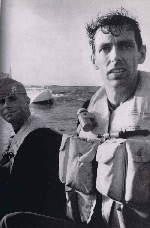 |
77k | Spray drenched and bone tired, Jacques Picard and Lt. Don Walsh pull away from U.S. Navy Bathyscaphe Trieste after their dive to a corrected depth of 35,800 feet. | Photo by Thomas J. Abercromie from the book Great Adventures with National Geographic, 1963. Page 330. | |
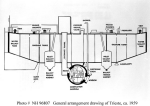 |
58k | U.S. Navy Bathyscaphe Trieste, General arrangement drawing, showing the bathyscaphe's main features. Drawing was released in connection with Trieste's record dive to 35,800 feet in the Challenger Deep, off Guam, on 23 January 1960. | USNHC # NH 96807. U.S. Naval Historical Center Photograph. | |
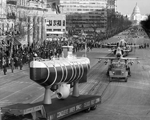 |
122k | A full-scale model of the Trieste at John F. Kennedy's Inaugural Day parade: 18 January 1961. | Photo & text courtesy of San Diego Union-Tribune. | |
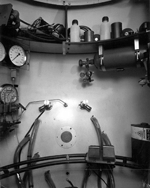 |
76k | The interior of the Trieste's 6½-foot-diameter pressure sphere: The two crew members could look outside through the small viewing port (lower center). The canister above contained oxygen, which was manually released when instruments indicated nitrogen levels were rising. | Photo & text courtesy of San Diego Union-Tribune. | |
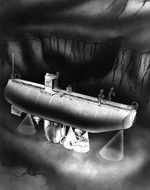 |
700k | This image is the artist's concept of Trieste with mechanical arm. The photo was released by the Naval Electronics Laboratory, San Diego, CA in July 1961. | Photo from the files of the Vallejo Naval and Historical Museum via Darryl L. Baker. | |
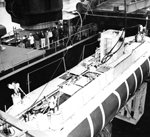 |
1.80k | Trieste being loaded aboard Point Defiance (LSD-31) by a floating crane. Photographed 14 April 1963, when the landing ship departed San Diego, California, to transport Trieste to New London, Connecticut, to take part in investigating the loss of Thresher (SSN-593). | Photo from the files of the Vallejo Naval and Historical Museum via Darryl L. Baker. | |
 |
101k | U.S. Navy Bathyscaphe Trieste in Boston en-route to the Thresher (SSN-593). | UPI photo courtesy of the Springfield Mass. Morning Union newspaper, 18 April 1963. Submitted by Stan Svec. | |
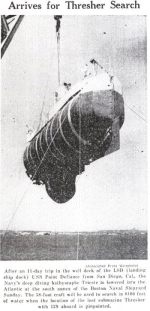 |
88k | U.S. Navy Bathyscaphe Trieste arrives after an 11-day trip in the well deck of the Point Defiance (LSD-31) from San Diego, CA. | A.P. Wirephoto courtesy of the Springfield Mass. Morning Union newspaper, 18 April 1963. Submitted by Stan Svec. | |
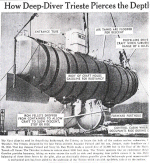 |
212k | U.S. Navy Bathyscaphe Trieste. | UPI photo courtesy of the Springfield Mass. Morning Union newspaper, 18 April 1963. Submitted by Stan Svec. | |
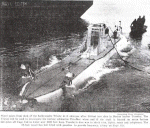 |
84k | Water pours from the deck of the U.S. Navy Bathyscaphe Trieste as it emerges after a 36 foot test dive in Boston harbor. The dive was to check trim, lights, sonar and telephones. | UPI photo courtesy of the Springfield Mass. Morning Union newspaper, 18 April 1963. Submitted by Stan Svec. | |
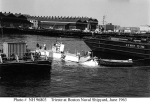 |
93k | U.S. Navy Bathyscaphe Trieste, operating at dockside at the Boston Naval Shipyard, Charlestown, Massachusetts, with a diver and crew assisting, 12 June 1963. Barge YC-764 is at right, and Billfish (SS-286) is in the center distance. Photographed by Belcher, Mobile Photo Group. View was probably taken during tests supporting the investigation into the loss of Thresher (SSN-593). | USNHC # NH 96803. U.S. Naval Historical Center Photograph. | |
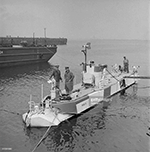 |
251k | (Original Caption) Lt. Donald Keach (left) and Lt. George Martin (right), who will man the Navy's deep-diving bathysphere, Trieste, stand on bow, as sailors aft make craft ready for sea. The Trieste, left the South Boston Naval Annex on 20 June 1963, under tow to take part in search for the sunken nuclear submarine,Thresher (SSN-593), some 220 miles east of Cape Cod. | Photo by Bettmann Collection/Getty Images, courtesy of gettyimages.com. | |
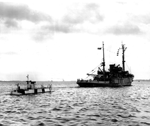 |
700k | Trieste under tow by the Preserver (ARS-8) in Boston harbor 20 June 1963 standing out to sea to search for the Thresher (SSN-593). | Photo from the files of the Vallejo Naval and Historical Museum via Darryl L. Baker. | |
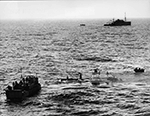 | 649k | The crew of the Trieste prepare to dive as they attempt to locate the sunken submarine Thresher (SSN-593) on 24 June 1963. The Preserver (ARS-8) appears above after towing her to the site. | Photo by Pictorial Parade/Getty Images, courtesy of gettyimages.com. | |
 |
74k | Commemorative post mark on the occasion of U.S. Navy Bathyscaphe Trieste fourth dive on 29 June 1963, while in search of the Thresher (SSN-593) in 1600 fathoms of water. | Photo courtesy of Jim Richardson. | |
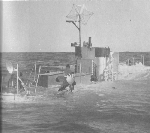 |
117k | U.S. Navy Bathyscaphe Trieste wallowing on the surface, awaiting a support ship. Note the small propellers for underwater manoeuvring. The kite-like affair is a radar reflector to help support ships locate the low-lying craft. | USN photo courtesy of The American Submarine, by Norman Polmar & submitted by Robert Hurst. | |
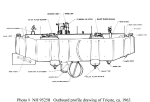 |
48k | Outboard profile drawing of U.S. Navy Bathyscaphe Trieste's configuration in about 1963, prepared for the Navy Museum, Washington, DC., during the early 1980s. Trieste was placed on exhibit in the Navy Museum in 1980. | USNHC # NH 95258. U.S. Naval Historical Center Photograph. | |
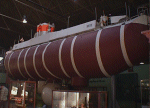 |
37k | Trieste on exhibit in the Navy Museum. | U.S.Navy Photograph. | |
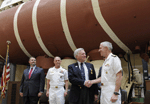 |
197k | Rear Adm. David Titley, Oceanographer of the Navy, congratulates retired Capt. Don Walsh, the first commander of the U.S. Navy bathyscaph Trieste on 15 April 2010. Titley presented Walsh with the Distinguished Public Service Award during a ceremony at the National Museum of the U.S. Navy at the Washington Navy Yard. Retired Rear Adm. Jay Deloach, right, director of Naval History & Heritage Command, and Rear Adm. Nevin Carr, Chief of Naval Research look on. | USN photo # N-7676W-101 by John F. Williams courtesy of news.navy.mil. | |
 |
188k | Oblique 3D-view of the Mariana region with the seafloor colored according to depth. | Photo from oceanexplorer.noaa.gov | |
Crew Contact And Reunion Information
Fleet Reserve Association
Additional Resources and Web Sites of Interest
US Navy Deep Submergence Group
RV TRIESTE II DSV 1
Trieste I & II
ROLEX History: 1960 Bathyscaph Trieste Record Dive
Woods Hole Oceanographic Institution
| Back To The Main Photo Index | Back To the Submarine Index |
|
Problems and site related matters, E-mail Webmaster |
|
This page was inspired by Mike Staehle,
created and maintained by Michael Mohl All Pages © 1996 - 2024 NavSource History All rights reserved. |